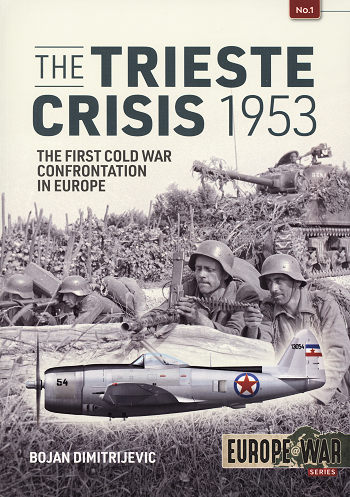 Even though I
was born only a few years prior to this, I can recall hearing about this, though
not really knowing what it was all about. Right at the end of WWII, the Yugoslav
Partisan Army moved north along the coast as quickly as it could and started
occupying the city of Trieste. From the other side, the Allied Army moved
quickly south and upon reaching Trieste, started moving the advanced forces of
the Yugoslav Army out of the city. This was a bloodless movement performed to
keep the city in Italy. Thus began eight years of political confrontation over
the city of Trieste and the surrounding area.
Even though I
was born only a few years prior to this, I can recall hearing about this, though
not really knowing what it was all about. Right at the end of WWII, the Yugoslav
Partisan Army moved north along the coast as quickly as it could and started
occupying the city of Trieste. From the other side, the Allied Army moved
quickly south and upon reaching Trieste, started moving the advanced forces of
the Yugoslav Army out of the city. This was a bloodless movement performed to
keep the city in Italy. Thus began eight years of political confrontation over
the city of Trieste and the surrounding area.
It is one of those instances where one side says they've
had control over the territory for years and the other says that many of the
people living there are ethnic Slavs and Croats so it should be ours. The first
thing that was done was the area was divided into a Zone A and a Zone B. The
British were the ultimate controling authority in Zone A, which was Trieste and
some of the surrounding area which included areas to the north. The Yugoslavians
controlled Zone B which was the area south and west of the city. The entire area
was called the Trieste Free Zone.
A policing force, which was developed and the two sides
coordinated to some extent. Tito, who controlled Yugoslavia wanted to forcibly
remove the Allies, but was too weak to do so without help. The Soviets were
unwilling to provide the assistance needed so it was a stalemate for a few
years. Things were not perfect as Allied aircraft routinely invaded the Yugoslav
section and after shooting down two straying USAF C-47s in 1946, tensions rose.
In the later 40's Stalin flatly told Tito that there was
no way the USSR would assist him in militarily taking over the Zone A and the
city of Trieste. This had a chilling effect on the Yugoslav leader and he
started to mollify his position. During all of this time there were talks to
come up with a solution to things. It was becoming fairly obvious that the
status quo wasn't the way to go and it would be more reasonable for the two
zones to officially become parts of either Italy or Yugoslavia.
Meanwhile Tito started becoming more and more friendly
towards NATO so Yugoslavia was able to get Mutual Defense equipment to help
prevent the Soviets from invading that section of the Balkans. It resulted in
them getting things like F-47 and F-84 Fighters, Mosquito fighter-bombers and
night fighters, C-47 transports, M47 tanks and lots of other mostly-US
equipment. There was even talk of having the country join NATO.
Through all of this the Italians were somewhat in the
background. They wanted Trieste as part of their nation so in 1953, they made
plans to occupy Zone A and started troop movements to reach this goal. The
Yugoslavs got wind of it and started to do the same thing with regards to Zone
B. Tensions were very high that there would be a shooting war.
The author does a commendable job of giving us the full
background as well as a fairly detailed story of both the political and military
aspects of the situation around Trieste. This includes unit information and
movements, the equipment they were using along with any specific mini-crises
that occurred in the area. This is accompanied by some excellent period photos,
some nice maps as some full color profiles just to spice things up a bit. It
makes for a truly good book on a series of events that few people know anything
about. Highly recommended.
November 2019
Copyright ModelingMadness.com
Review book courtesy of
Casemate Publishing, where you can order your copy
at this
link.
If you would like your product reviewed fairly and quickly, please
contact
me or see other details in the
Note to
Contributors.
 Even though I
was born only a few years prior to this, I can recall hearing about this, though
not really knowing what it was all about. Right at the end of WWII, the Yugoslav
Partisan Army moved north along the coast as quickly as it could and started
occupying the city of Trieste. From the other side, the Allied Army moved
quickly south and upon reaching Trieste, started moving the advanced forces of
the Yugoslav Army out of the city. This was a bloodless movement performed to
keep the city in Italy. Thus began eight years of political confrontation over
the city of Trieste and the surrounding area.
Even though I
was born only a few years prior to this, I can recall hearing about this, though
not really knowing what it was all about. Right at the end of WWII, the Yugoslav
Partisan Army moved north along the coast as quickly as it could and started
occupying the city of Trieste. From the other side, the Allied Army moved
quickly south and upon reaching Trieste, started moving the advanced forces of
the Yugoslav Army out of the city. This was a bloodless movement performed to
keep the city in Italy. Thus began eight years of political confrontation over
the city of Trieste and the surrounding area.